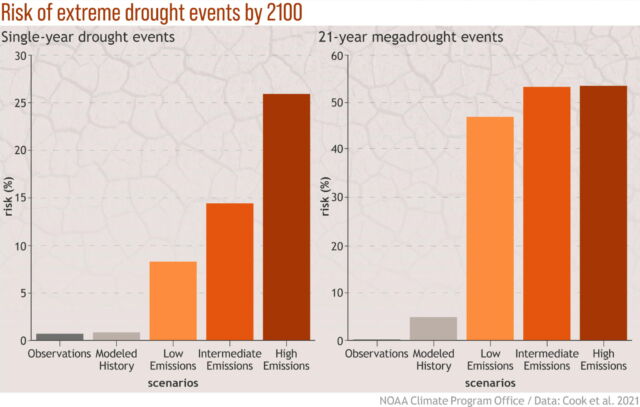Droughts in the coming decades could be longer than projected by current climate models, a new study published Wednesday in Nature warns.
The international team of scientists examined potential biases that could skew climate models used to make drought projections under Intergovernmental Panel on Climate Change midrange and high emissions scenarios. The researchers corrected for the bias by calibrating those models with observations of the longest annual dry spells between 1998 and 2018.
By the end of this century, they found that the average longest periods of drought could be 10 days longer than previously projected. Trouble spots included North America, Southern Africa, and Madagascar, where the newly calibrated models showed that the increase in the longest annual dry spell could be about twice what the older models predicted.
“Our study pinpoints global regions where current climate model projections of drought increases may be underestimated,” said lead author Irina Petrova, a hydrological extremes researcher at Ghent University in Belgium. The new information can help raise awareness of growing drought risks for populations in the affected areas, “but also should call for the attention of policymakers and governing organizations, prompting them to reassess future drought hazards in these regions and take adequate actions.”
The study identified a drought hotspot in southwest North America, including the southern states of the US and northern parts of Mexico, she said. The findings suggest that droughts in some parts of the region could be five days longer than projected “as early as 2040, nearly 60 years sooner than previously anticipated,” she said.
In contrast to most of the planet, the new study suggests that, in central East Asia, dry intervals between rain storms are decreasing at a rate four times greater than suggested by non-calibrated models under both IPCC emissions scenarios.
“Our finding of a significant underestimation of future decrease in dry period length in central East Asia is notable in itself, suggesting potential for increased future flood risks in the region,” Petrova said. But she cautioned that the region’s climate is complex and that the uncertainties associated with observations in that region made it hard to calibrate the models.
In any case, she said, “It is no longer in doubt for us that most of the global land will experience an increase in dry extremes in the future. A significant portion of the global population is already living under water stress… creating an urgent situation that demands immediate attention.”
Worse than expected
The finding that droughts could be longer than projected by the IPCC fits a pattern of recent research showing that various climate impacts are accelerating and could be worse than expected and arrive sooner than projected by the panel. Its reports are only issued every five to seven years and represent a scientific consensus that can be diluted by politics.
Notable in the recent research are signs of a slowdown of the key heat-transporting current in the Atlantic Ocean, the Atlantic Meridional Overturning Current, which sustains a temperate climate in much of northwestern and western Europe. Several recent studies provide evidence that the current could weaken enough by 2100 to cause an extreme climate shift with global ripples.

NOAA Climate Program Office/Hunter Allen and Anna Eshelman

